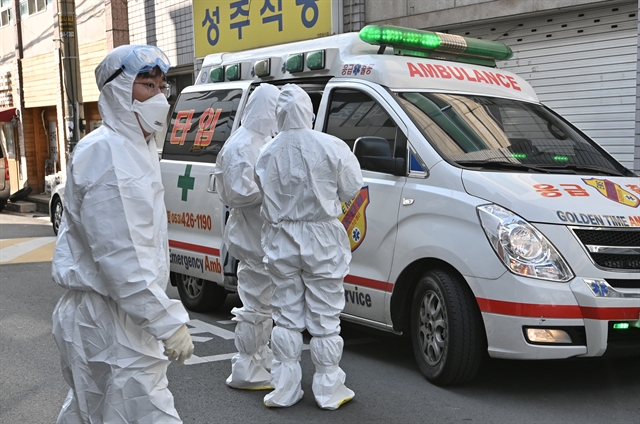 World
World


|
| South Korean medical workers wearing protective gear visit a residence of people with suspected symptoms of the COVID-19 coronavirus to take samples, near the Daegu branch of the Shincheonji Church of Jesus in Daegu. — AFP/VNA Photo |
SEOUL — South Korea reported 476 new cases of the coronavirus on Monday, bringing the total number of infections here to 4,212, as the nation provides an "all-out response" to the fast-spreading virus that includes a massive testing programme.
So far, 22 people, mostly ones with underlying illnesses, have died in South Korea from the respiratory virus that emerged in China.
About 60 per cent of confirmed cases have been linked to a branch of Shincheonji religious sect in the southeastern city of Daegu.
Of the 476 new cases, 377 are in Daegu, 300 kilometers southeast of Seoul, and 68 are in neighboring North Gyeongsang Province, according to the Korea Centers for Disease Control and Prevention (KCDC). The total number of cases in Daegu and North Gyeongsang stood at 3,081 and 624, respectively.
The Monday morning update was based on the number of virus patients tallied at midnight. Previously, a morning update had been based on the number tallied at 9am on the day, but health authorities changed it to help front-line health workers spend more time battling the virus.
The second update, to be posted Monday afternoon, will be based on the number tallied between Sunday midnight and 4pm on Monday, officials said.
Other major provinces and cities have also reported some infections, with Seoul's confirmed cases rising by four to 91.
The virus cases in Busan rose by five to 88, and Seoul's neighboring Gyeonggi Province saw its total cases climb by three to 92. The total number of cases in South Chungcheong Province rose by 10 to 78.
With virus patients in Daegu skyrocketing, the city's hospitals have been overwhelmed and an increasing number of doctors and nurses in the city have been vulnerable to infection.
Vice Health Minister Kim Gang-lip said in a daily briefing that the government opened an isolation facility in Daegu where virus patients with mild symptoms can be admitted.
About 160 patients will be admitted to the facility, Kim said, adding that two more of such facilities will be set up this week.
Critically ill people infected with the virus are treated in so-called negative-pressure rooms at hospitals to prevent the virus from further spreading within hospitals.
Since raising the virus alert level to "red," the highest level, on February 23, health authorities have focused on halting the spread of the virus in Daegu, the epicenter of the virus outbreak here, and North Gyeongsang Province.
On Sunday, President Moon Jae-in said the government "is now waging an all-out response after raising the crisis alert to the highest level."
In Daegu and North Gyeongsang, temporary treatment facilities will be expanded to exclusively handle suspected cases and diagnostic examinations, Moon said.
"I believe that an increasing number of people will join these efforts and that we will succeed in defeating the virus without fail," Moon said.
Experts said the number of confirmed cases is expected to increase in the coming days as health authorities have begun testing more than 210,000 members of the Shincheonji Church of Jesus at the center of the rapid spread in other provinces.
After the first outbreak on January 20 in South Korea, the pace of infections had not been alarming until Feb. 18, when a 61-year-old woman who is tied to the Daegu religious sect tested positive for the virus.
Since then, the nation has seen an explosion in infections as it accelerated virus tests on potential cases.
South Korea has released 31 fully recovered novel coronavirus patients from hospitals as of midnight Sunday, and one more patient will be cured by later in the day, the KCDC said.
The number of people being checked for the virus and under quarantine came to 33,799, it added. The country has tested a total of 105,379 suspected cases, with 71,580 testing negative.
Currently, there is no evidence that the new coronavirus is airborne. The World Health Organisation said the virus is transmitted through droplets or close contact. The best measure to protect yourself from the virus is to wash your hands with soap for at least 20 seconds and avoid mass gatherings, health officials said. — YONHAP




